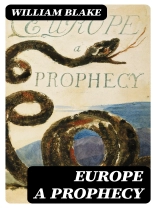William Blake’s ‘Europe: A Prophecy’ serves as a profound and richly symbolic exploration of the social and political upheavals characterizing late 18th-century Europe. This prophetic work employs a visionary style, characterized by vivid imagery and allegorical figures, to critique the prevailing powers, ideologies, and religious institutions. Blake navigates through themes of conflict, revolution, and regeneration, using a complex interplay of text and intricate illustrations to invoke a sense of urgency about the moral and spiritual awakening of humanity in the face of tyranny and oppression. Blake, an emblematic figure of the Romantic era, was not merely a poet but also a painter and printmaker whose intricate artistic vision informed his written works. Living during a time of intense sociopolitical transformation, including the Enlightenment and the French Revolution, Blake felt an acute disconnection from the established norms and beliefs of his time. His personal conviction in the importance of individualism and emotional truth greatly influenced the writing of ‘Europe: A Prophecy, ‘ adding layers of personal and societal critique. This text is a crucial read for those interested in the intersection of art and politics, as well as for enthusiasts of Blake’s unique visionary aesthetic. ‘Europe: A Prophecy’ invites readers to engage deeply with its provocative themes, rewarding them with insights not only into Blake’s mind but also into the tumultuous era from which these ideas emerged.
Yazar hakkında
William Blake (1757–1827) was a seminal figure in the history of the poetry and visual arts during the Romantic Age in England. Born in London, he began his artistic career as an engraver but is celebrated today for his poetic and mystical abilities. Blake combined his talents in both texts and accompanying illustrations, believing that visual and literary arts were inherently connected and served to enhance each other. He created a method of printing his works that allowed him to produce the illustrations and the text simultaneously, which he called ‘illuminated printing.’ Among his extensive repertoire, ‘Europe A Prophecy’ (1794) stands out as part of his prophetic books which convey his idiosyncratic and esoteric mythologies, reflecting his views on society, politics, and the human condition. Blake’s work was not widely recognized during his lifetime, but he is highly regarded today for his expressiveness and creativity, as well as his philosophical and mystical thoughts. His style is distinguished by its symbolism, strong emotional undertones, and sometimes unorthodox use of mythology. Although his work was once considered obscure, Blake is now appreciated for his visionary qualities, and his poetry, in particular, is acclaimed for its originality, metaphoric richness, and depth of thought.












